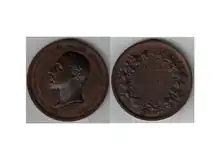| Colonial and Indian Exhibition | |
|---|---|
 The Queen Opening the Colonial and Indian Exhibition: Procession passing the principal entrance to the Indian Palace", The Illustrated London News, May 1886.[1] | |
| Overview | |
| BIE-class | Unrecognized exposition |
| Name | Colonial and Indian Exhibition |
| Area | South Kensington |
| Visitors | 5.5 million |
| Location | |
| Country | United Kingdom of Great Britain and Ireland |
| City | London |

_-_BL.jpg.webp)
The Colonial and Indian Exhibition of 1886 was held in South Kensington in London with the objective to (in the words of the then Prince of Wales) "stimulate commerce and strengthen the bonds of union now existing in every portion of her Majesty's Empire".[2] The exhibition was opened by Queen Victoria, and when it closed had received 5.5 million visitors.[3]
It was housed in a collection of purpose-built buildings designed in an Indian style.
Display
In 1886, the bonds of the Empire were intended to be strengthened by the Colonial and Indian Exhibition. In New Zealand, there was a suggestion that the showcases should be made of native woods. A fernery was included in the New Zealand Court and a display of frozen mutton represented the burgeoning agricultural industries. A pātaka (storehouse), originally carved in the 1850s dominated the large Maori collection assembled by naturalist Walter Buller along with the tomb of a Ngati Pikiao chief.[4][5] A series of Māori portraits by Gottfried Lindauer, within an ethnological context, was also shown. In another building, the fine art section, consisted of over one hundred paintings, mostly New Zealand landscapes. Among them was The Haunt of the Moa, a Scene in a Puriri Forest (1885) by the artist Kennett Watkins.[5]
Exhibits shown included a ceremonial sword from the colony of Lagos,[6] a grasshopper swatter from the Straits Settlements,[7] and Albert Bierstadt's painting of the Bahama Islands After A Norther was displayed in the West Indian gallery, and admired by the Prince of Wales[8]
The Indian artware section was split into different areas representing the various princely states. The Rajputana entrance was a large Jaipur gate constructed of and provided by the then Maharaja of Jaipur.[3] The Gwalior gateway which had been displayed at the Calcutta International Exhibition (1883) was loaned by the Victoria and Albert Museum.[9]
Several dozen Indian artisans were present at the exhibition, displaying the process of crafting their artisanal works. The men were reputedly from a prison in Agra, and historians have described their presence as part of an effort by colonial officials in India to demonstrate how they were conducting a long-term project to "reform the criminal castes".[10]
Legacy
The Jaipur Gate built for the exhibition was renovated in 2004, and is on display at the Hove Museum and Art Gallery.[3]
The Durbar Hall exhibited at the exhibition is on display at the Hastings Museum and Art Gallery.

References
- ↑ The Illustrated London News, 8 May 1886, p. 478.
- ↑ Saloni Mathur, India by Design: Colonial History and Cultural Display (Berkeley: U of California P, 2007), p.57.
- 1 2 3 "The Jaipur Gate". Retrieved 12 March 2012.
- ↑ "British Museum - Search object image". Retrieved 12 March 2012.
- 1 2 Wolfe, Richard (11 November 2019). "International Exhibitions". Auckland Museum. Archived from the original on 1 February 2020. Retrieved 30 April 2021.
- ↑ "British Museum - Search object details". Retrieved 12 March 2012.
- ↑ "British Museum - Search object details". Retrieved 12 March 2012.
- ↑ "The Haggin Museum - Collections: Art: Albert Bierstadt: After Norther, Bahamas". Retrieved 4 April 2012.
- ↑ "Photographic guardbooks: Images of India | Victoria and Albert Museum". 24 September 2013. Retrieved 4 January 2017.
- ↑ Mathur, Saloni (2007). India by Design: Colonial History and Cultural Display. University of California Press. p. 60. ISBN 9780520234178. OCLC 76481430. Retrieved 13 January 2015.
External links
- Photograph of a Maori tomb on display at the exhibition
- Illustration of the Jaipur Gate at the time of the exhibition
- The British Museum collection database - enter "The Colonial and Indian Exhibition" for a list of objects from the exhibition in the British Museum collection
- Colonial and Indian Exhibition, 1886 Official Catalogue. London: William Clowes and Sons. 1886. ISBN 0665052553. Retrieved 13 January 2015.